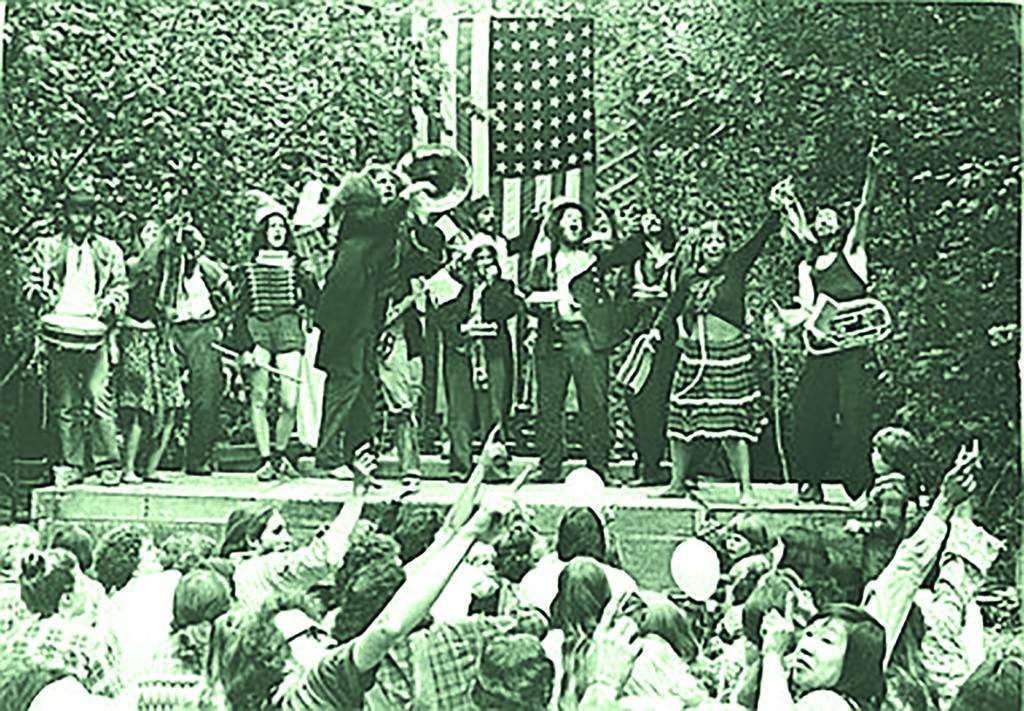History, Mystery, and Magic
This summer marks the 50th anniversary of monumental American landmarks such as the Apollo 11 moon landing and Woodstock, but sadly these milestones are now just nostalgic historical snapshots. However, also back in 1969, a discrete groovy hippie happening took root in Eugene, Oregon, that continues to this day. It started as the Oregon Renaissance Faire and was billed as a “come in costume” fundraiser for the alternative Children’s Community School. Three thousand people attended. In 1970 the annual event moved 13 miles west to its current location in Veneta, where it has continued uninterrupted along the forested banks of the Long Tom River.
The name eventually changed to the Oregon Country Fair. On the second weekend of July this year, “the Fair,” as it has been affectionately dubbed, celebrates its Golden Jubilee. More than 50,000 are expected—quite a success story! On this occasion we have been asking ourselves, “What is it about the Fair that makes it the granddaddy of transformational festies?” The answer—magic. Let’s explore.
Founded by hippies with idealistic countercultural values, the Fair received an immortal dose of magic in 1972 when Springfield Creamery (makers of Nancy’s yogurt) owners Chuck and Sue Kesey faced bankruptcy. In seeking a solution, it didn’t hurt that Chuck’s famous brother (author and Merry Prankster Ken Kesey) had built a long history with the Grateful Dead as part of the Acid Tests. In his own right, Chuck had been “on the bus” long enough to know Jerry Garcia personally and one day the then young man summoned the courage to drive to California to ask if the band might consider playing a benefit concert, on short notice, to save the Creamery. He got a yes.
Later that summer, on August 27, as temperatures hit 105 degrees in Veneta, the Dead knocked one out of the park in a famous concert known by Deadheads as Sunshine Daydream (later made into a documentary film). It is said that the “Dark Star” (an iconic Grateful Dead song) performed that day was so inspired that NASA agreed to include it in a space capsule designed for potential communication with extraterrestrial life. Was it the Grateful Dead’s extraterrestrial juju? The Kesey mystique? Hard to say, but old-time fairgoers point to “The Day a Rock Band Saved a Yogurt Company” as part of the Fair’s foundational good vibe.

A decade later, in 1982, the Grateful Dead-Kesey connection was rekindled as the boys returned to Veneta to play a follow-up benefit. This time the proceeds went to obtain final ownership of the fairgrounds property—446 idyllic acres that were all put into a 501c3 nonprofit that year. Good deeds beget good deeds. Over the years the Fair has maintained a philanthropic attitude, having donated more than $1.5 million, mostly to local youth-oriented charities.
Volunteerism is a critical component of the Fair’s magic. With the exception of a few paid staff positions the whole operation is run by volunteers, some in roles that are handed down from generation to generation. With an event attracting more than 50,000 there’s plenty to do.
Let’s look at just one aspect—music and entertainment. With 20 official stages hosting everything from headliners such as Phil Lesh and the Terrapin Family Band (yes, that’s Grateful Dead founding member Phil Lesh bringin’ it back for the Jubilee) to eccentric vaudevillian reviews to avant garde jam bands and everything in between. Ya gotta love the quirky stage names like Morningwood Odditorium, Daredevil Palace, Mighty Tiny Puppet, W.C. Fields, Hoarse Chorale, Rabbit Hole, Monkey Palace, and Chez Ray’s Next—not to mention the Ritz, which besides managing a full schedule of live music operates a large-scale public sauna.
Volunteers bring a pride of work and agency
that profoundly contributes to the Fair’s magic, but volunteerism also has its own rewards.
Fair volunteers earn a coveted staff bracelet that allows them onsite camping privileges and after-hours access. The way it works is that fair tickets are sold to the public, granting access during daylight hours only. Once the sun goes down large staff crews form a web of human nets by locking arms together to create “the sweep.” Canvassing the entire grounds (including river marshes and port-a-potties) the sweep ushers all those without a staff wristband to the exits. After the sweep, thousands of gnomes and fairies and frolicking staffers let their hair down for an all-night round of revelry and merry mischief.
Fair managers are sticklers. They care passionately about upholding the values and integrity of the event. One clear example of this is seen in the arduous vetting process for the 700 booths selected for vending. Stewards uphold strict criteria so that offerings are homespun, artisanal, unconventional, earth friendly, and non-commercial. Mass producers need not apply. Shop around and you’re apt to find a handmade wooden kaleidoscope, or a handy dulcimer, or a jar of locally produced organic bee pollen tied with a bow, but good luck finding anything made by Coca Cola or Pepsi. In our modern, hyper-mechanized world, the Fair holds firmly to its original idealistic ‘60s era counterculture values. To put it another way—the Fair never sold out! What’s not to love?
It’s a challenge to summarize 50 years of magic in a page but we hope we’ve piqued your interest and that you’ll be steered to explore this successful hippie holdout, where healthy ways are nourished and Good Samaritans still win. OregonCountryFair.org
Sean Ahearn has volunteered as MC at the Spirit Tower Stage for 15 years. Rob Sidon is publisher and editor in chief of Common Ground.